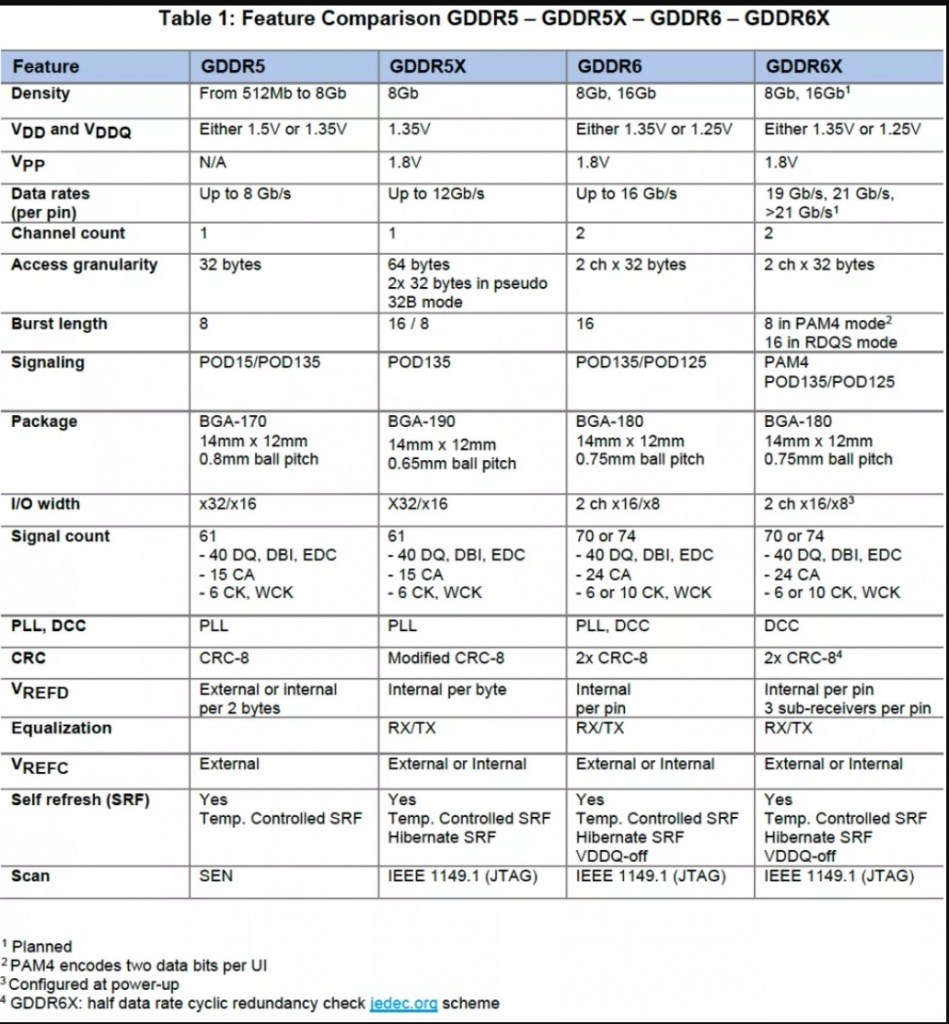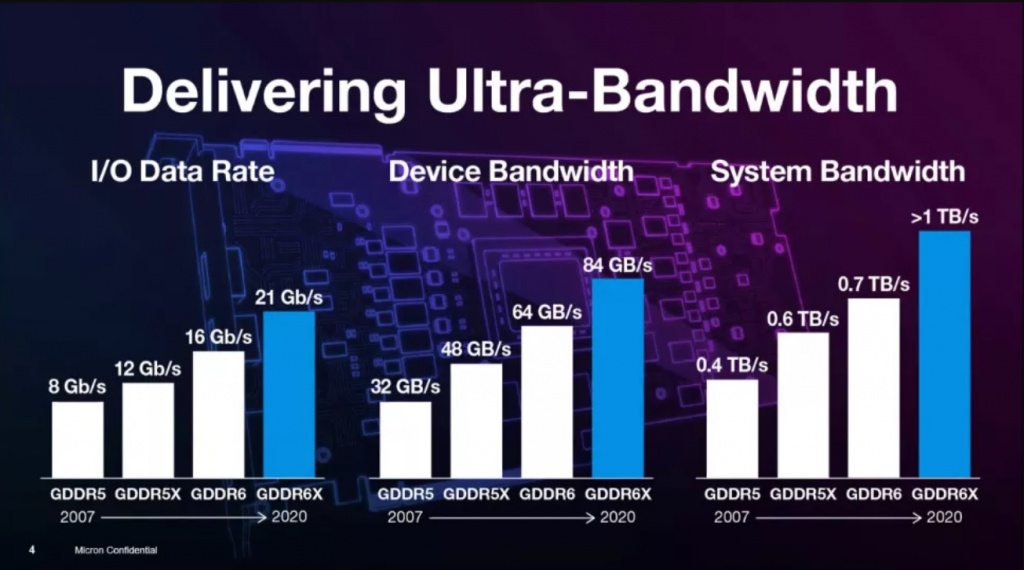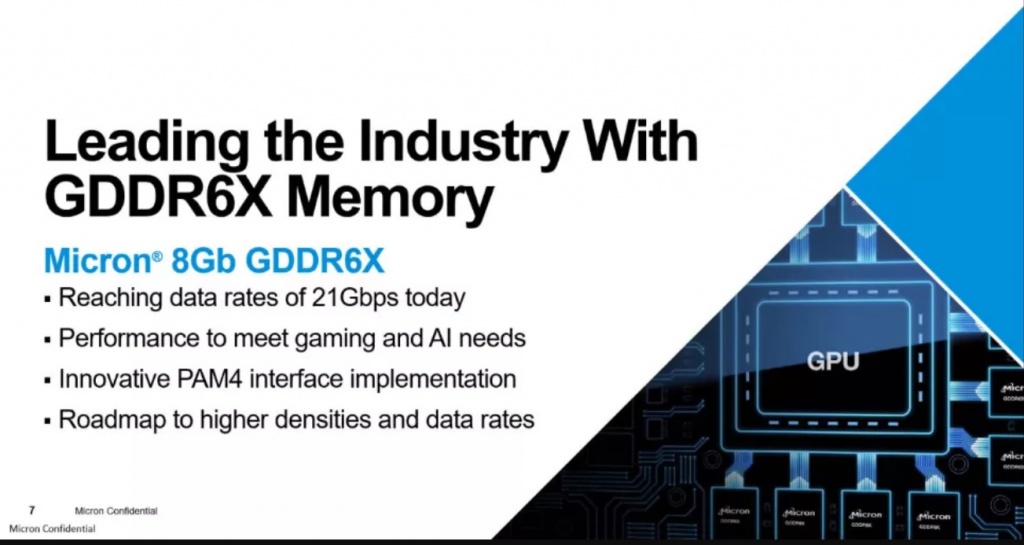GDDR6X Technical Improvements Explained
On September 1st, 2020 Nvidia announced its brand new RTX 3000 series of graphics cards which promised unprecedented levels of performance not only in traditional rasterized rendering but also in raytracing. The RTX 3000 series of cards would go on to become some of the fastest cards in the market competing with AMD’s top offerings in the RX 6000 series. The Ampere based GPU that was inside these cards was plenty fast on its own, but the vastly superior performance was actually a result of another improvement as well.

A big part of that performance came from the memory that was onboard these cards. The top two cards of the RTX 3000 series, the RTX 3080 and RTX 3090 sported a brand new memory type that had not been used in gaming-grade graphics cards before, known as GDDR6X. This new type of memory promised double the bandwidth compared to the standard GDDR6 that was found on the RTX 2000 series and the AMD RX 6000 series cards. Let’s see what makes GDDR6X so special.
What exactly does VRAM do?
Most of the “heavy-lifting” in terms of graphical processing is done by the core of the graphics card which is known as the GPU. The GPU is a very powerful piece of silicon that is designed and optimized to process graphical tasks such as games. It handles most of the processing that is required in order to push the frames that your monitor displays. But in order to process large amounts of data and prepare the frames quickly enough, the GPU needs something to work on. This is where VRAM comes in.
VRAM or Video Memory is a very high-speed memory form that is stored on the graphics card itself so that the GPU has direct access to it. The VRAM stores assets and textures that are required by the game so that the GPU can work on them when needed and prepare the frames that need to be displayed. If the VRAM cannot deliver these assets and other crucial data to the GPU fast enough, the user can experience slowdowns, stutters, or even crashes. Generally, higher resolutions like 1440p and 4K with high graphical settings require more VRAM to manage and store those higher-quality assets, which means that you need a higher capacity of VRAM if you want to play at these settings at these resolutions. Simultaneously, you need higher speed memory in order to move the data to the GPU from the VRAM quickly enough. This is where memory technologies like GDDR6X prove helpful.
Mechanism behind GDDR6X
Micron Technology (the company that manufactures and supplies the GDDR6X memory to Nvidia and other partners) recently released some details about the mechanism behind GDDR6X memory. This gives us a better idea of how this technology is able to achieve the extremely high bandwidth numbers.
PAM4 Signaling
Unlike typical data pathways called “buses” which move data 1 bit at a time, GDDR6X uses a technique called PAM4 (Four-Level Pulse Amplitude Modulation), which is a method that can send 1 out of 4 discrete power levels at a time instead of 2. This means that GDDR6X can move 2 bits at a time which dramatically increases the bandwidth. Micron does have a history of interesting innovation like this as it brought the industry’s first GDDR5, GDDR5X, and now GDDR6X chips to mass production. Micron was the only producer of GDDR5X and is now the exclusive manufacturer of GDDR6X. Micron had the following to say about the development of GDDR6X using PAM4:
“At Micron, we had scientists look into how to utilize PAM4 in memory already since 2006,” said Ralf Ebert, Micron’s director of the graphics segment. “I intentionally said scientists because I would differentiate between developers and scientists. These were the guys really doing the groundwork for the innovation. They basically took this PAM4 technology and tried to figure out how can we use that in DRAM. The scientists had to work side by side with the GDDR developers, the guys that signed the chip,” said Ebert. “They also collaborated very closely with the system and product engineers that understand the challenges from the system and mass manufacturing perspective.”
There is a limitation that comes with this exciting new technology though. GDDR6 has a burst length of 16 bytes (BL16), meaning that each of its two 16-bit channels can deliver 32 bytes per operation. GDDR6X has a burst length of 8 bytes (BL8), but because of PAM4 signaling, each of its 16-bit channels will also deliver 32 bytes per operation. This means that GDDR6X is not faster than GDDR6 on the same clock speeds. This also means that since GDDR6X carries twice as many signals as GDDR6 during each cycle, it is also much more efficient. GDDR6X is 15% more power-efficient than GDDR6 (7.25 pj/bit vs 7.5 pj/bit) at the device level, according to Micron.

Close Collaboration with Nvidia
A big driving force behind the push for higher bandwidth and higher speeds has been Nvidia itself, which has collaborated closely with Micron during the development and testing phases of the GDDR6X Memory. Nvidia is the only launch partner of Micron when it comes to GDDR6X memory, which means that the new memory type will be exclusive to Nvidia cards for quite some time. Nvidia has already installed the new memory on their flagship GeForce gaming graphics cards; the RTX 3090 and RTX 3080, which have thus gotten tremendous leaps in bandwidth over last-gen GDDR6.

Nvidia has also designed a brand new memory controller and PHY for the GDDR6X since it uses PAM4 signaling, and by the looks of it, everything has been designed in-house by Nvidia itself. The GDDR6X technology should also be coming to more cards by Nvidia, particularly the TITAN and Quadro series which could benefit greatly from the increased bandwidth of GDDR6X coupled with higher capacities. Micron has also confirmed that Nvidia is not an exclusive partner for GDDR6X and that more companies would also be getting the new memory standard later on. This means that we can expect AMD’s Radeon cards to also have some sort of GDDR6X application when more of those cards launch in the future.
GDDR6X with PAM4 vs HBM2
Although GDDR6X with its fancy new PAM4 technology is still more expensive to manufacture than GDDR6, it is not even close to the cost of HBM2 manufacturing. HBM or High Bandwidth Memory really seemed like the future of graphics card memory technology a couple of generations ago. AMD was pushing really hard to bring HBM to the mainstream market and they launched a series of really underwhelming GPUs too with HBM onboard. The Fury and the Vega line of graphics cards used High Bandwidth Memory, but sadly their GPU cores were not fast enough to give them any sort of an advantage over Nvidia.
The flashy HBM2 memory was once again brought back in the Radeon VII, AMD’s new high-end graphics card based on the Vega architecture but now built on the 7nm process. The HBM2 inside the Vega cards was extremely expensive to manufacture and had low yields, leading to low supply and even lower demand. The Radeon VII could not come close to Nvidia’s flagship, the RTX 2080Ti, and faced EOL within a year of its launch. The much faster Nvidia flagship uses the standard GDDR6.
AMD itself moved away from their HBM endeavors after a change in the company’s hierarchy and several high-ranking members were relieved of their duties. The new AMD Radeon swiftly moved away from the HBM memory obsession and onto much more realistic memory choices like the GDDR6 memory found within the RX 5000 and RX 6000 series of GPUs. The main problem with HBM2 is its manufacturing. The process is extremely tedious and expensive as the HBM2 KGSDs (known-good stacked dies) have to be assembled at a semiconductor fab and then placed on an interposer next to a GPU in a cleanroom of another fab. This makes production much more expensive and laborious than GDDR6 or even GDDR6X because GDDR6X does not require stacking, and it’s shipped as discrete chips that can be soldered down at a factory.

There is one caveat that needs to be noted here, though. GDDR6X chips need a very clean and stable signal, which is why the Nvidia memory controller on the GA102 GPU that powers the memory chips now sits on a separate power rail. This ensures that the chips receive their required clean and stable power that they need to function properly.
PAM4 for the Future
PAM4 signaling is an interesting and really exciting new process that can find its applications in several areas of PC hardware. While right now it is limited to the GDDR6X application in graphics cards, the signaling technique can have many more uses in other processes in the future. Micron does believe that the future of memory is the PAM 4 technique.
“So, GDDR6X is where we introduced PAM4, and we definitely can see that moving forward,” said Micron’s director of graphics memory. “Potentially, PAM4 can be used in other memory standards. It is possible or likely that this type of technology will get used by corporations with CPUs or our other processors.”
Another interesting future application of the PAM4 signaling standard is PCIe Gen 6.0 which is due in 2021. It uses PAM4 signaling to extract more efficiency and higher data rates. Since PCIe has a very wide adoption range, CPU and ASIC companies will have to eventually adopt PAM4 and PCIe 6.0 at some point in time. Maybe someday it will also be used in HBM2 memory to provide unreal bandwidth and speed but that is just speculation on our part.
Where is GDDRX Used?
Even if we put the future aside for a second, GDDR6X is still used in many important applications today. Some of the important ones include:
- Gaming: The biggest and most popular use of GDDR6X memory is of course in gaming. Micron has provided the GDDR6X modules to Nvidia for integration into their brand new RTX 3080 and RTX 3090 graphics cards. This memory will allow them to achieve unprecedented numbers in terms of memory bandwidth and speed. The first generation of GDDR6X can achieve data transmission rates of up to 1TB/s. This can prove extremely beneficial in terms of next-generation gaming.
- HPC: The GDDRX technology is used in HPC or High-Performance Computing. It is characterized by highly parallel computations executing advanced application programs reliably, efficiently, and as fast as possible. These computing solutions are used by scientists, researchers, engineers, and academic institutions to solve complex problems.
- Professional Virtualization: Industries like healthcare and medicine, professional video post-processing, financial simulations, weather forecasting, or oil and gas rely on really high-end workstations that can use the power of GDDR6X memory to streamline and optimize their workflow. These high-performance workstations are a key use case for the new GDDR6X.
- Artificial Intelligence: The GDDRX memory technologies are used in Artificial Intelligence and its derivatives like Deep Learning. These workloads are becoming more and more important as well as prevalent, and high-speed computing solutions like GDDRX can definitely help in this regard.

Final Words
GDDR6X is a new type of memory that has been developed by Micron in close collaboration with Nvidia. The memory uses a new technology called PAM4 signaling which is a very innovative architectural process in which the effective data transmission rate is doubled. The signaling technique also lowers energy usage and thus makes the memory more efficient.
Nvidia has implemented the memory into its new RTX 3080 and RTX 3090 cards, and this is just the beginning of the GDDR6X memory’s eventual rollout into the gaming market. The memory is easier and cheaper to manufacture than HBM2 and gives tremendously promising results, so it seems like the whole industry is going to adopt this standard sooner or later. Right now, the GDDRX technologies are found in many sectors including gaming, HPC, professional virtualization, and AI.





